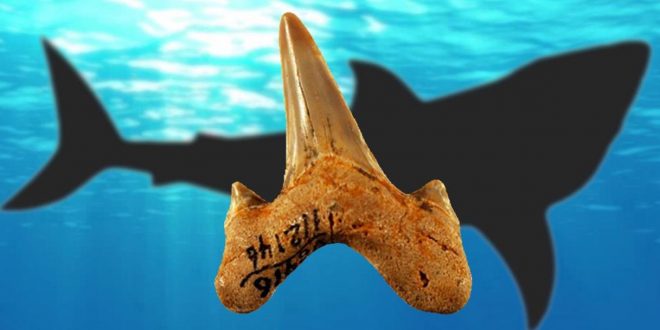Scientists have discovered a rare new species of extinct shark that roamed the oceans 20 million years ago. Dubbed Megalolamna paradoxodon, the predator was identified by its widely dispersed tooth fossils, which have been recovered from beds as far apart as California, North Carolina, Peru, and Japan.
The new species, which was identified in research published this week in the journal Historical Biology, had unique teeth that required the researchers to create a new genus (Megalolamna) to categorize it. While some of its dental features are similar to other otodontids, others are similar to those of the modern salmon shark, a member of the genus Lamna. The latter part of its name, paradoxodon, means “paradoxical teeth” and further illustrates this dental oddity.
Megalolamna paradoxodon’s discovery came as a bit of a shock to lead author Kenshu Shimada, a paleobiologist at DePaul. In a statement, he called it “remarkable that such a large lamniform shark with such a global distribution had evaded recognition until now, especially because there are numerous Miocene localities where fossil shark teeth are well sampled.”
Discovery also leads to reclassification for megatoothed sharks
The largest of the new shark species’ teeth measure approximately 1.8 inches (4.5 cm) in length, which allowed Shimada’s team to determine that the creature was nearly 13 feet (4 meters) long, or roughly the same size as a modern great white shark. The teeth in the front of its mouth would have been ideal for grasping, they said, while the rear teeth were designed for slicing.
The unusual appearance of the new species leaves a currently unresolved 45-million-year gap in the fossil record from when Megalolamna likely split from its closest relative Otodus, the study authors explained. Furthermore, its discovery led the team to determine that the megalodon and other members of its lineage should be classified into this genus, not the genus Carcharocles.
“The idea that megalodon and its close allies should be placed in Otodus is not new,” Shimada said, “but our study is the first of its kind that logically demonstrates the taxonomic proposition.” The inclusion of these megatoothed sharks into the genus Otodus makes it a more complete line, a “monophyletic group” considered to be closely relate to Megalolamna, the researchers added.
“Carcharocles megalodon has been the typical expression for the fossil shark,” he added in an interview with LiveScience. “However, our new study clearly supports the idea suggested by a few previous workers that ‘megalodon’ should be placed within the genus Otodus, and thus it should be referred to as Otodus megalodon from now on.”
Agencies/Canadajournal
 Canada Journal – News of the World Articles and videos to bring you the biggest Canadian news stories from across the country every day
Canada Journal – News of the World Articles and videos to bring you the biggest Canadian news stories from across the country every day



